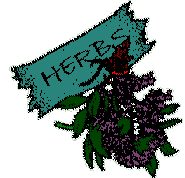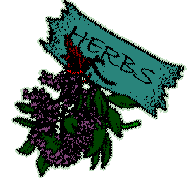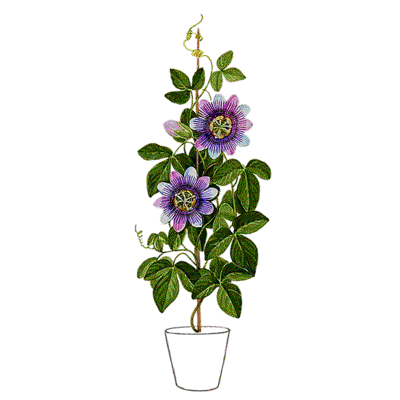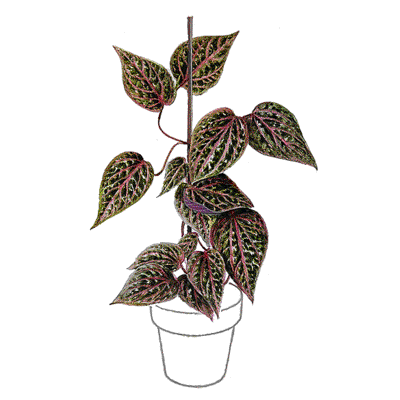 Herbs--P
Herbs--P 
 |
Common Names: Parsley, Persil, Devil's Oatmeal, Perceley Latin Name: Petroselinum crispum Parts Used: Leaves, stems, roots, and seeds Cultivation: Parsley is a hardy biennial. It doesn't transplant well, so sow the seeds where you wish it to grow. Cut the flowers off as they appear the second year or you will have all flower and no leaves. Cosmetic Uses: Add parsley infusions to your bathwater to soothe and cleanse. Culinary Uses: Everyone is familiar with the soggy piece of curly parsley that appears on your plate in restaurants. Curly parsley is used most often as a garnish as it has a relatively mild flavor. Flat or Italian parsley is used frequently in cooking and has a strong flavor that mixes well with just about any dish. Use it fresh (dried has NO flavor), and add to foods towards the end of cooking. Magickal Uses: Parsley promotes fertility and encourages lust. Use it in purification baths. Sprigs of parsley were once used on plates to keep food from becoming contaminated. Medicinal Uses: Parsley has more vitamin C, proportionally, than an orance. Take infusions of parsley for bladder infections. It is also rich in other vitamins, like A, several B's, and contains good quantities of calcium and iron.Parsley increases milk production and tones uterine muscles. The chlorophyll acts as a natural breath freshener. Cautions: Large quantities can cause decreased blood pressure and pulse. It can also irritate the kidneys if overused. |
 |
Common Names: Passionflower, Passionvine Latin Name: Passiflora incarnata Parts Used: Flowers and fruit Cultivation: Passionflower is a tender perennial, hardy only to zone 7. It grows in fertile, well-drained soil in partial shade. Magickal Uses: Grow passionflower in your home to promote peace and calm troubles. The passionflower is associated with the Crucufixion, by virtue of the shape of the flowers and the number of its parts, although it was assuredly not known in Biblical times. Medicinal Uses: Passionflower extract has a slightly narcotic effect and is frequently used as a non-addictive sedative. It is specific for anxiety, tension, and insomnia. |
 |
Common Names: Pennyroyal, Mosquito Plant, Pudding Grass, Tickweed Latin Name: Mentha pulegium (European); Hedeoma pulegoides (American) Parts Used: Leaves and flowers Cultivation: European pennyroyal is a perennial, hardy to zone 5, that prefers rich, moist, slightly acidic humous in full sun to part shade. American pennyroyal is a hardy annual growing in average dry soil in full sun. Magickal Uses: Pennyroyal protects against the evil eye, prevents weariness while travelling, and promotes peace. Medicinal Uses: Pennyroyal is an extremely effective abortifacient; however, the effective dose is also a toxic amount.It is used mostly as an insect repellent and is very effective against fleas, mosquitos, and ticks. Cautions: NEVER take pennyroyal internally except under direct medical supervision. It should NEVER be used by pregnant women. |
 |
Common Names: Pepper Latin Name: Piper negrum Parts Used: Dried peppercorns Cultivation: Pepper is a vining tropical plant that does well as a houseplant. It prefers bright, indirect light, such as that coming through sheer curtains, and warm temperatures. It will not fruit indoors. Culinary Uses: Pepper is a popular seasoning, second only to salt in its widespread use. Avoid the preground pepper and grind your peppercorns when you use them for added flavor. Black and white pepper are the two most common forms; they come from the same plant but are prepared differently. White pepper has its outer skin removed before drying; it has a milder flavor. There are also "gourmet" peppers available in an increasingly wider range of colors, each with a slightly different flavor. Use whole peppercorns in marinades; grind them for use in just about everything else. Magickal Uses: Pepper protects against the evil eye. Mix it with salt and scatter throughout your house to dispel evil. |
Common Names: Pokeweed, Crowberry, Inkberry, Poke Root Latin Name: Phytolacca americana Parts Used: Root Cultivation: Pokeweed is a very hardy perennial shrub. It likes moist humous in full sun to part shade. It is rarely cultivated, as the whole plant tends to give off a nasty smell. Magickal Uses: Sprinkle an infusion of pokeweed around the house to break hexes. Crush the berries and use their juice as a magickal ink. Medicinal Uses: Pokeweed is used to stimulate the lymphatic system and treat tonsillitis, mastitis, and mumps. Use it externally to treat skin disorders. Cautions: All parts of the fresh plant are toxic, as are the dried berries. It can cause fetal abnormalities if used during pregnancy. |